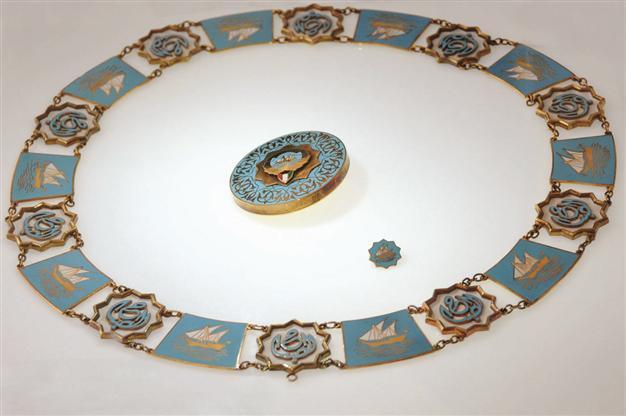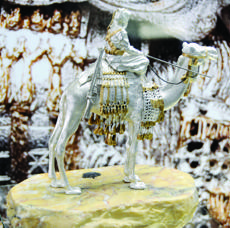Show sheds light on gifts to Tito
BELGRADE

A letter, written by Fatma Berin Menderes and sent to Yugoslav leader Tito, is also on display in the exhibition ‘Royal Gifts’ along with 68 unique artifacts from different museum collections. AA photos
An exhibition in Belgrade is showcasing an exclusive selection of gifts that late Yugoslav leader Josip Broz Tito was presented with when meeting members of royal families from 17 countries in Europe, Asia and Africa, as well as a letter from Turkey’s first democratically elected leader.The exhibition titled “Royal Gifts” opened on July 21 in the remodeled building of the Museum “May 25th,” allowing royal gifts to be displayed in all their glory for local exhibition-goers and tourists, who have flocked to see the artifacts belonging to the collections of the Museum of Yugoslav History.
Speaking about the exhibition, museum official Momo Cvijovic said that in the archives of the museum, they had found a letter written by Fatma Berin Menderes, the wife of the first democratically elected Turkish prime minister, Adnan Menderes, and that the letter was written on Jan. 4, 1962, and delivered to Tito by the Yugoslavian Embassy in Ankara.
In the letter, Menderes says that after the 1961 execution of her husband, the gifts presented to the family were seized on the grounds that the gifts were “government property,” said Cvijovic.
“During Tito’s visit to Turkey and Menderes’ visit to Yugoslavia, some gifts were presented. She asks in the letter which gifts were at the ‘state level’ and which ones were ‘individual.’ Tito personally replied to the letter, saying the two statues that he gave to Adnan Menderes were at the state level and that the others, including a gold cigarette case and a ring, were personal gifts. But unfortunately, we did not have a chance to follow the further developments about these gifts.”
It is also reported that Berin Menderes also sent letters to Greece and Yugoslavia to find a solution to the seizure of the gifts.
 Gift-giving has a symbolic value
Gift-giving has a symbolic valueThe exhibition features 68 unique artifacts and shining examples of craftsmanship made in the most famous workshops around the world that have been divided into six segments: archaeological discoveries, objects for everyday use, decorative objects, jewelry, decorations and portraits of members of royal families. The chosen pieces, covering the period from the seventh century B.C. to the first half of the 20th century, are made of precious metals, gems and the finest porcelain.
The artifacts, documents and photographs introduce visitors to the etiquette and customs of the exchange of gifts between statesmen. Gift-giving has a symbolic value across cultures and the exchange at the highest level is governed by the strict rules of protocol – from the choice of gifts, depending on the occasion, interests and status of the receiving party and the very act of conferring a gift, to the accompanying documents and the subsequent storing of the items received as gifts from Queen Elizabeth II of England, Reza Shah Pahlavi of Iran, King Paul I of Greece, Prince Norodom Sihanouk of Cambodia and Ethiopian Emperor Haile Selassie, among others.
The rich array of Tito’s activities as a statesman is best illustrated by the fact that throughout his administration, Tito met around 350 heads of state and government, went on 169 state visits and stayed in 73 countries by invitation. During these numerous meetings, he received a great many gifts that are kept today in the Museum of Yugoslav History.
The largest number of exhibits are gifts from Cambodia’s prince, whom Tito met most frequently: a fragment from a temple in Angkor Thom, the former Khmer capital, which had been kept in a museum before it was given to Tito as a gift; a silver tea set decorated with representations of the legendary creature, Garuda (according to the Hindu myth Garuda is the carrier of the god Vishnu); and a metal model of an imperial two-wheeled cart.
During the 2,500-year celebration of the Persian Empire in Teheran in 1971, Reza Shah Pahlavi presented Tito with a replica of the Decree of Cyrus the Great, known as the Cyrus Cylinder, dating back to 539 B.C. The famous clay, cylinder-shaped document was placed under the walls of Babylon as a foundation deposit. It is regarded as the first written record of human rights, since it guarantees religious tolerance, bans slavery and grants the right to self-determination, as well as people’s right to take up a job of their own choosing. The Cyrus Cylinder is now kept in the British Museum, and its replica is on display in the United Nations building in New York, where it was translated into all six official languages of the United Nations. King Paul I of Greece and Queen Frederica gave Tito a present of two gold replicas of famous 15th-century B.C. gold cups from Crete, while former Afghan King Mohammad Zahir gave the Yugoslavian leader a statue of Buddha. The deposed Ethiopian emperor gave Tito a unique gift on the occasion of the First Non-Aligned Movement Summit in 1961.
A special segment
A special segment consists of the decorations all countries featured in the exhibition awarded to Tito in recognition of the deeds performed in war and peace. Among them, the most venerable European ones stand out – the Danish Order of the Elephant (founded in 1464), the Swedish Order of the Seraphim and the British Order of the Bath.
The exhibition can be visited through Aug. 25.
















